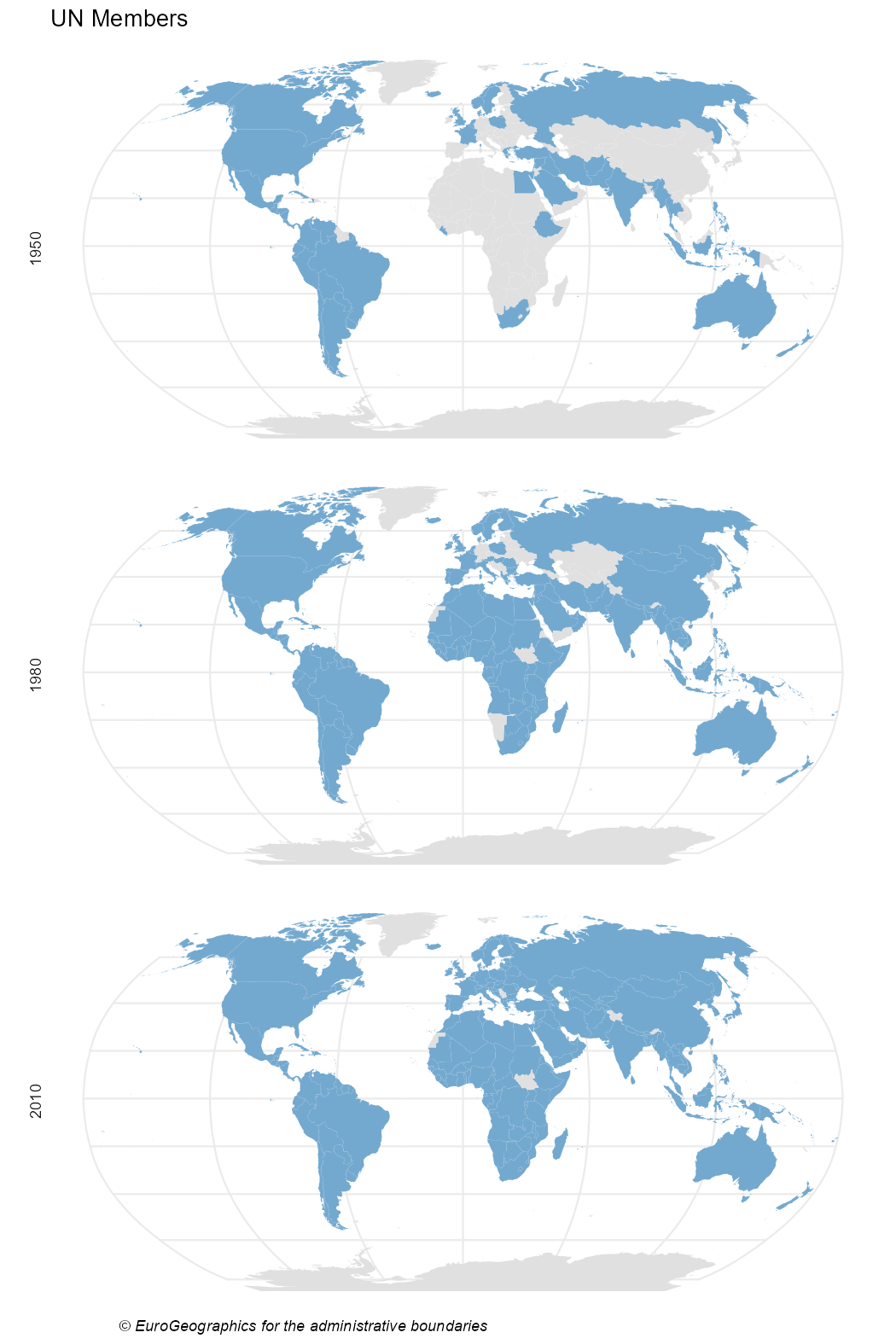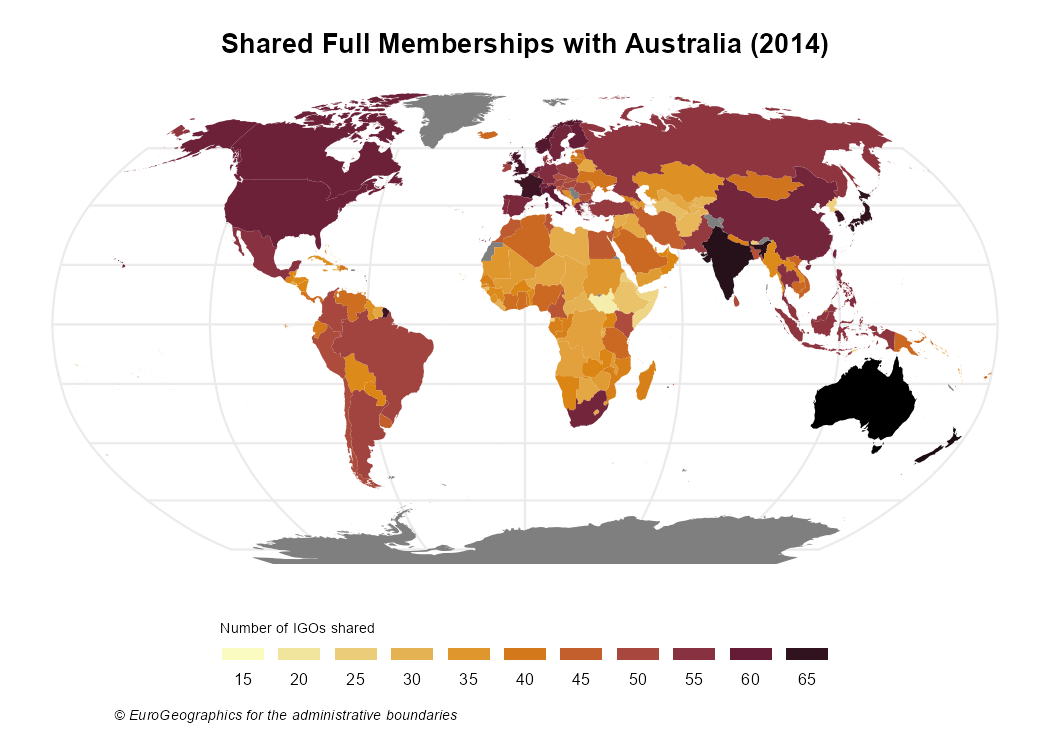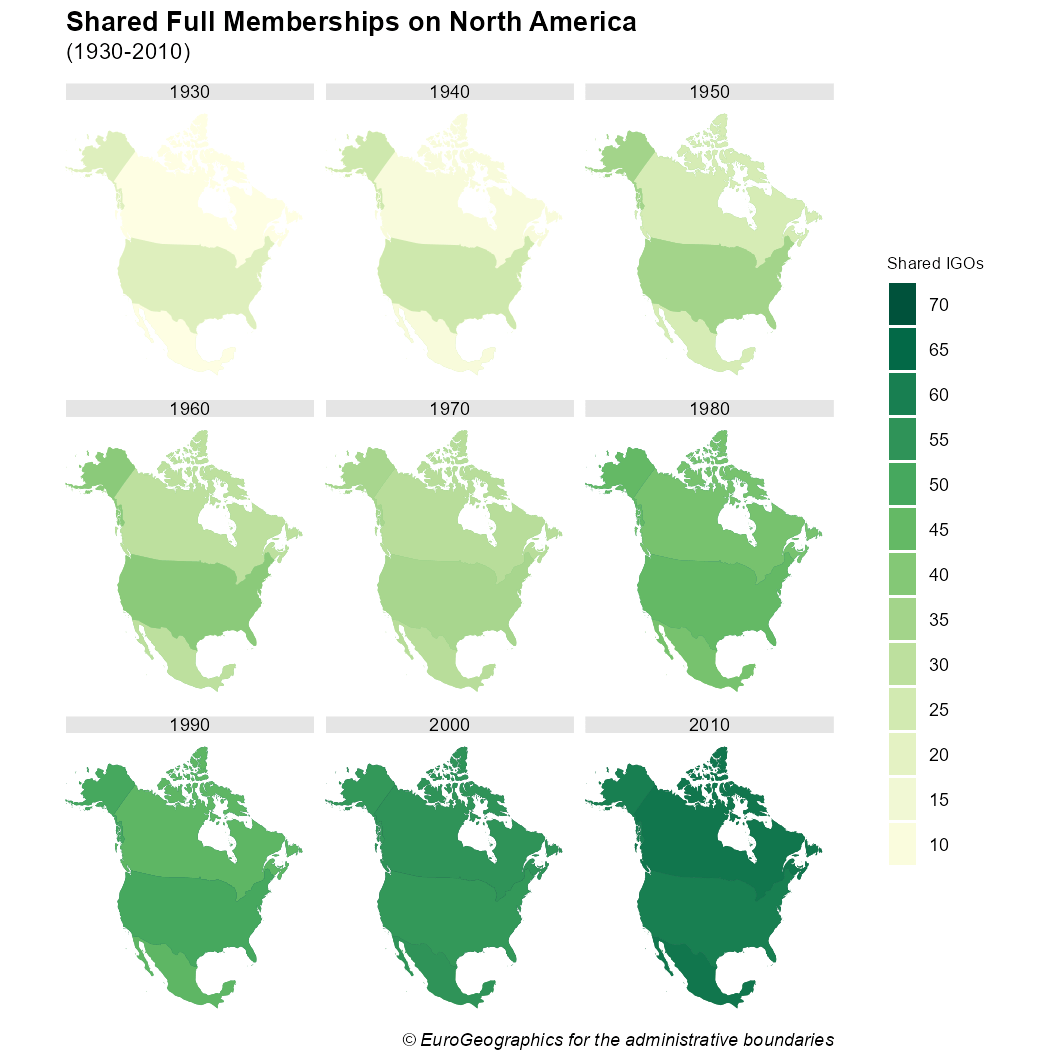Maps are a powerful tool to show data. As the scope of igoR are the Intergovernmental Organizations, mapping and IGOs are a perfect match.
This vignette provides some geospatial visualizations using the IGO data sets (Pevehouse et al. 2020) included in this package. Specific packages used for geospatial data:
- giscoR for extracting the shapefiles of the countries.
- ggplot2 for plotting.
Also countrycode is a very handy package for translating between coding schemes (CoW, ISO3, NUTS, FIPS) and country names.
library(igoR)
# Helper packages
library(dplyr)
library(ggplot2)
library(countrycode)
# Geospatial packages
library(giscoR)
library(sf)Evolution of the composition of UN
The following maps shows the evolution of countries that are members of the United Nations. First we should extract the data:
# Extract shapes
world <- gisco_get_countries()
# Extract three dates - some errors given that ISO doesnt have every COW Code
un_all <- igo_members("UN", c(1950, 1980, 2010), status = "Full Membership") %>%
# Add ISO3 Code
mutate(ISO3_CODE = countrycode(ccode, "cown", "iso3c", warn = FALSE)) %>%
select(year, orgname, ISO3_CODE, category)
# Auxiliar data.frame to collect every ISO3-year pairs
base_df <- expand.grid(
ISO3_CODE = unique(world$ISO3_CODE),
year = unique(un_all$year),
stringsAsFactors = FALSE
) %>%
as_tibble()
# Merge everything with the spatial object
un_all_sf <- world %>%
# Expand to all cases
left_join(base_df, by = "ISO3_CODE") %>%
# Add info
left_join(un_all, by = c("ISO3_CODE", "year"))Note that the map is not completely accurate, as the base shapefile contains the countries that exists on 2016. Some countries, as Czechoslovakia, East or West Germany are not included.
Now we are ready to plot with ggplot2:
ggplot(un_all_sf) +
geom_sf(aes(fill = category), color = NA, show.legend = FALSE) +
# Robinson
coord_sf(crs = "ESRI:54030") +
facet_wrap(~year, ncol = 1, strip.position = "left") +
scale_fill_manual(
values = c("Full Membership" = "#74A9CF"),
na.value = "#E0E0E0",
) +
labs(
title = "UN Members", caption = gisco_attributions(),
) +
theme_minimal() +
theme(
plot.caption = element_text(face = "italic", hjust = 0.15),
axis.line = element_blank(),
axis.text = element_blank()
)
UN Members
Number of shared memberships
Shared memberships are useful for identifying regional patterns. The following code produces a map showing the number of full memberships shared with Australia for each country on the world:
## Number of igos shared - 2014
# Countries alive in 2014
states2014 <- states2016 %>%
filter(styear <= 2014 & endyear >= 2014)
# Shared memberships with Australia
shared <- igo_dyadic("AUL", as.character(states2014$statenme),
year = 2014
) %>%
rowwise() %>%
mutate(shared = sum(c_across(aaaid:wassen) == 1)) %>%
mutate(ISO3_CODE = countrycode(ccode2, "cown", "iso3c",
warn = FALSE
)) %>%
select(ISO3_CODE, shared)
# Merge with map
sharedmap <- world %>%
left_join(shared, by = "ISO3_CODE") %>%
select(ISO3_CODE, shared)
# Plot with custom palette
pal <- hcl.colors(10, palette = "Lajolla")
# Plot
ggplot(sharedmap) +
geom_sf(aes(fill = shared), color = NA) +
# Australia
geom_sf(
data = sharedmap %>% filter(ISO3_CODE == "AUS"),
fill = "black", color = NA,
) +
# Robinson
coord_sf(crs = "ESRI:54030") +
scale_fill_gradientn(colours = pal, n.breaks = 10) +
guides(fill = guide_legend(nrow = 1)) +
labs(
title = "Shared Full Memberships with Australia (2014)",
fill = "Number of IGOs shared",
caption = gisco_attributions()
) +
theme_minimal() +
theme(
plot.title = element_text(face = "bold", hjust = 0.5),
plot.caption = element_text(face = "italic", size = 7, hjust = 0.15),
axis.line = element_blank(),
axis.text = element_blank(),
legend.title = element_text(size = 7),
legend.text = element_text(size = 8),
legend.position = "bottom",
legend.direction = "horizontal",
legend.title.position = "top",
legend.text.position = "bottom",
legend.key.width = unit(1.5, "lines"),
legend.key.height = unit(0.5, "lines")
)
Shared Full Memberships with Australia (2014)
Cross-shared memberships
The following map shows how the relationships between the countries of North America has flourished on the last 90 years, using a year as representative of each decade.
# Select years
years <- seq(1930, 2010, 10)
# Shared memberships
cntries <- c("USA", "CAN", "MEX")
all <- igo_dyadic(cntries, cntries, years) %>%
rowwise() %>%
mutate(value = sum(c_across(aaaid:wassen) == 1)) %>%
mutate(ISO3_CODE = countrycode(ccode1, "cown", "iso3c")) %>%
select(ISO3_CODE, year, value)
# Create map
# Get shapes
countries_sf <- gisco_get_countries(country = c("USA", "MEX", "CAN")) %>%
left_join(all, by = "ISO3_CODE")
# Map
ggplot(countries_sf) +
geom_sf(aes(fill = value), color = NA) +
coord_sf(crs = 9311, xlim = c(-3200000, 3333018)) +
facet_wrap(~year, ncol = 3) +
scale_fill_gradientn(
colors = hcl.colors(10, "YlGn", rev = TRUE),
breaks = seq(0, 100, 5)
) +
guides(fill = guide_legend(reverse = TRUE)) +
labs(
title = "Shared Full Memberships on North America",
subtitle = "(1930-2010)", fill = "Shared IGOs",
caption = gisco_attributions()
) +
theme_minimal() +
theme(
panel.grid = element_blank(),
axis.line = element_blank(),
axis.text = element_blank(),
strip.background = element_rect(fill = "grey90", colour = NA)
)
Shared Full Memberships on North America (1930 - 2010)
